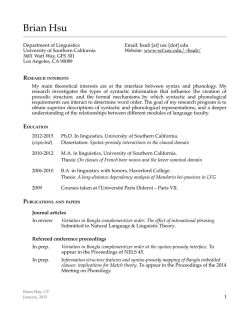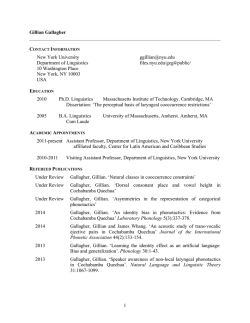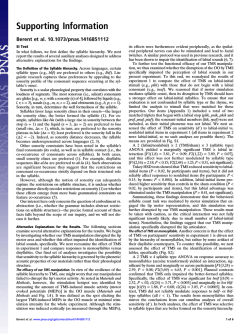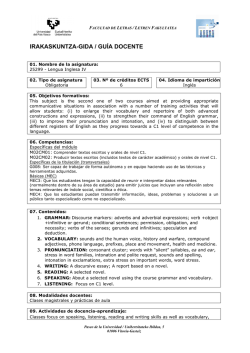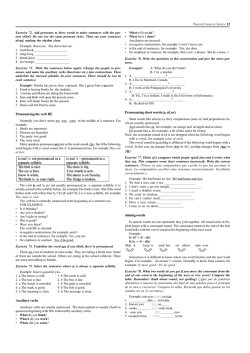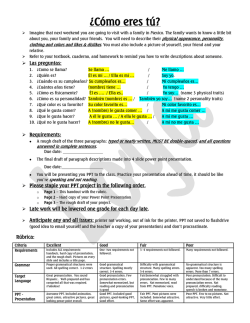
INTRODUCTION TO PHONETICS AND PHONOLOGY Course Code
THE OPEN UNIVERSITY OF TANZANIA Faculty of Arts and Social Sciences P.O. Box 23409 Dar Es Salaam http://www.out.ac.tz Tel: 255-22-2668820/2668992-Ext.2115 Fax: 255-22-2668759 Direct Line: 022 - 2667255 E-Mail: [email protected] Course Title: INTRODUCTION TO PHONETICS AND PHONOLOGY Course Code OLL 235 Date of Official Approval: Academic Year: 2012 2014/15 Course Description: The course deals with introduction to general phonetics and phonology. It specifically deals with introduction to the concepts of phonology and phonetics, approaches to the study of phonetics, role and importance of each approach, how speech sounds are produced and transmitted, production, recognition and transcription of speech sounds and RP phonemes and RP phonemes in sequence, the effect of phonetic environment on the segmental phonemes, syllables, stress, English rhythm: vowel reduction, strong forms, weak forms and speech simplification strategies in English. Keywords: Phonetics, Phonology, Syllables, International Phonetic Alphabets, stress, Productivity Tools: Hard copies, Internet Course Leader: N/A Course Tutors: Zelda Elisifa External Examiner: “as appointed by University Authorities from time to time” COURSE VALUE: TYPE LEVEL 2 CREDITS/UNITS 2 LEARNING HOURS 35 ASSESSMENT MARKING SCHEME: To be provided by the instructor. Delivery mode: Open and distance learning. DELIVERY PATTERN: ODL Lectures In Face to Face Session Contact Hours, And Laboratory Practical OTHER REQUIREMENTS: Students are required to attend to the laboratory practical for the distinction of speech sounds. Sometimes they will need to have mirrors for observing the different shapes of the lips while articulating vowel phonemes. ADDITIONAL COMMENTS: Students are required to have internet access and in a more convenient way i.e. wireless internet access. COURSE AIMS: This course aims at equipping students with both theories, and conceptual frameworks of phonetics in general and Received Pronunciation Phonology. It will equip them with Skills and Knowledge on the process of speech sounds production, as well as how theories related to distinctive features applied in distinguishing consonant speech sounds in contrast to vowel sounds. Moreover, students will be equipped with knowledge related to RP syllable parts, structures and their phonetic and phonemic transcriptions. LEARNING OUTCOMES: Knowledge and understanding; To develop critical awareness of Phonetics in General and English Language Phonology Discuss and describe basic concepts related to phonetics and phonology. Transcribe and pronounce syllables, words and long stretches of English Language Generic cognitive & intellectual skills: Develop capacity for critical analysis and arguments related to Phonetics and Phonology Critically, develop the ability to describe the relations between Manner of articulation and Places of articulation and how to determine the International Phonetic Chart as per theories of International Phonetic Alphabets (IPA). Practical knowledge/professional skills: Be competent to discuss and describe basic differences between phonetics and phonology Be competent to explain the theories and processes governing production of human speech sounds Be competent in explaining the distinctive features of human speech sounds and how they determine differentiation of Consonants and vowels. Be competent in describing and explaining basic RP phonemes and their distinctive features Be competent to describe the parts and structures of RP syllables Key transferable skills. Differentiate between phonetics and phonology Explain how speech sounds are produced Recognize, transcribe and describe speech sounds and RP phonemes Analyze and describe the structures of RP Syllables Describe different prosodic features and transcribe, recognize and produce different patterns of connected English speech Course Contents. TOPIC 1: General Phonetics 1.1 Definition of phonology and phonetics 1.2 Approaches to phonetics 1.2.1 Articulatory phonetics 1.2.2 Auditory phonetics 1.2.3 Acoustic phonetics 1.2.4 The organs of speech and the air streams mechanism 1.2.4.1 Active and passive articulators 1.2.4.2 Pulmonic airstream mechanism 1.2.4.3 Glotalic airstream mechanism 1.2.4.4 Velaric airstream mechanism 1.2.4.5 Oral, nasal and nasalized sounds TOPIC 2. The Phonemic Theory and the Phone 2.1. The status of a phoneme 2.1.2 Nature and functions of a phoneme 2.2 Phonemes versus allophones 2.3 Complementary distribution 2.4 Free variation 2.5 The phone 2.6 Phonetic transcription versus phonemic transcription 2.7 Broad versus narrow transcription 2.8 The International Phonetic Alphabet (IPA) 2.9 The consonants classification 2.10 The vowels classification TOPIC 3 English Segmental Phonology 3.1. The RP accent 3.2 The RP phonemes 3.2.1. Transcription of RP phonemes 3.2.1.1 Transcription of RP consonant phonemes 3.2.2.2 Transcription of RP vowel phonemes 3.2.2.3 Description of RP phonemes 3.2.2.3.1 Description of RP consonants and the consonant chart 3.2.2.3.2 The RP vowel trapezium 3.3 The RP phonemes and English orthography TOPIC 4 Suprasegmentals and the English Connected Speech 4.1 The syllable 4.1.1 The syllable, its structure and approaches 4.1.1.1 Different views of the syllable 4.2 The RP syllable 4.3 Phonotactic constraints TOPIC 5 INTONATION 5.1. Stress 5.2. Stress in English 5.3. Rhythm 5.3.1 Rhythm in English 5.3.2 Pitch, tone and intonation 5.4. Intonation and focus in English 5.5 Tone and tone languages 5.6 Speech simplification strategies in English. Learning strategy: This will entail students visiting various libraries in search for Phonetics and Phonology books; they will have group discussions,, face to face sessions and practical applications. Assessment strategy: Compulsory Student Progress Portfolio (SPP), timed test and final examination. Assessment criteria: One Timed Test Annual examination Total Pass Mark shall be Grading shall be as follows; A B+ B C D E 30% 70% 100% 40% Excellent Very Good Good Satisfactory Marginal Fail Absolute Fail 70%-100% 60%- 69% 50%- 59% 40%- 49% 35%- 39% 0%- 34% Indicative Resources: Fromkin, V.A ed. (1978). Tone A Linguistic Survey. New York Academic Press. Gimson, A.C (1994). Pronunciation of English. London: Arnold (5th edn, revised by A.Crutttenden) ___________(1971) A Practical Course English Pronunciation. Boston. Ladefoged, P. (1993). A Course in Phonetics. 3rd edn.New York:Harcourt BraceJovanovich. Maghway, J.B (1988). Aspects of Prosody in English and Kiswahili: Edinburgh University. ___________(1980). Spoken English in Tanzania. Spelling and Pronunciation of Vowels. O’Connor, J.D (1980). Better English Pronunciation. Cambridge University Press. Peter, Rouch (1991). English Phonetics and Phonology: A Practical Course. Cambridge University Press.
© Copyright 2025
